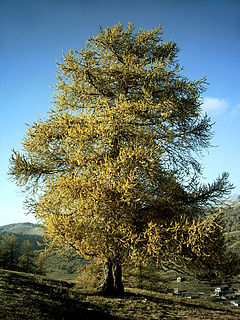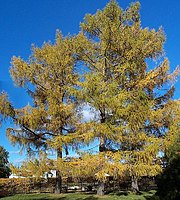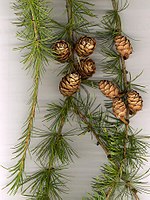Larch
| Larch | |
|---|---|

| |
| Larix decidua in autumn | |
| Scientific classification | |
| Kingdom: | |
| Division: | |
| Class: | |
| Order: | |
| Family: | |
| Genus: | Larix |
| Species | |
|
About 10–14; see text | |
Larches are conifers in the genus Larix, in the family Pinaceae. Growing from 20 to 45 m tall (65 to 147 ft),[1] they are native to much of the cooler temperate northern hemisphere, on lowlands in the north and high on mountains further south. Larches are among the dominant plants in the boreal forests of Siberia and Canada.
Although they are conifers, larches are deciduous trees that lose their leaves in the autumn. The shoots are dimorphic, with leaves borne singly on long shoots typically 10–50 centimetres long[2]: 47 and bearing several buds, and in dense clusters of 20-50 needles on short shoots[2] only 1–2 mm long with only a single bud. The leaves are needle-like, 2–5 centimetres long, slender (under 1 cm wide). The needles are deciduous, turning yellow and falling singly in the late autumn, leaving the trees leafless through the winter.
The female cones of larches are erect, small, 1–9 cm long, green or purple, ripening brown 5–8 months after pollination; in about half the species the bract scales are long and visible, and in the others, short and hidden between the seed scales. Those native to northern regions have small cones (1–3 cm) with short bracts, with more southerly species tending to have longer cones (3–9 cm), often with exserted bracts, withith the longest cones and bracts produced by the southernmost species, in the Himalayas.
Deciduous conifers
A deciduous conifer is a tree with needle leaves and cones holding the seeds that change color and lose leaves in autumn. The chlorophyll (chemical that makes leaves green) fades in autumn into a red or yellow according to the gain of carotene (chemical that makes leaves go yellow) or anthocyanins (chemical that makes leaves go red). Larch takes in the carotene which is why they turn yellow in autumn.
Larch is one of very few deciduous conifers, since most conifers (cone bearing trees with needle leaves) are evergreen and most deciduous trees are broadleaf (flat leaved trees). Larch is one of four deciduous conifer species, dawn redwood (metasequoia), swamp cypress (taxodium) and of course larch (Larix).
Species and classification
There are eleven accepted species of larch:[3]
- Larix czekanowskii Szafer
- Larix decidua Mill. (syn. L. europaea D.C.) European larch. Mountains of central Europe.
- Larix gmelinii (Rupr.) Kuzen. (syn. L. dahurica) Dahurian larch. Plains of central and eastern Siberia.
- Larix griffithii Hook.f. (syn. L. griffithiana) Himalayan larch. Mountains of eastern Himalaya
- Larix kaempferi (Lamb.) Carr.(syn. L. leptolepis) Japanese larch. Mountains of central Japan.
- Larix laricina (Du Roi) K.Koch Tamarack larch or American larch. Parts of Alaska and throughout Canada and the northern United States from the eastern Rocky Mountains to the Atlantic shore.
- Larix lyallii (Parl.) Subalpine larch. Mountains of northwest United States and southwest Canada, at very high altitude.
- Larix mastersiana Rehder & E.H.Wilson Masters' larch. Mountains of western China.
- Larix occidentalis Nutt. Western larch. Mountains of northwest United States and southwest Canada, at lower altitudes.
- Larix potaninii Batalin Chinese larch. Mountains of southwestern China (Sichuan, northern Yunnan).
- Larix sibirica Ledeb. Siberian larch. Plains of western Siberia.
In the past, the cone bract length was often used to divide the larches into two sections (sect. Larix with short bracts, and sect. Multiserialis with long bracts), but genetic evidence[4] does not support this division, pointing instead to a genetic divide between Old World and New World species, with the cone and bract size being merely adaptations to climatic conditions. More recent genetic studies have proposed three groups within the genus, with a primary division into North American and Eurasian species, and a secondary division of the Eurasian into northern short-bracted species and southern long-bracted species;[5] there is some dispute over the position of Larix sibirica, a short-bracted species which is placed in the short-bracted group by some of the studies and the long-bracted group by others.
Most if not all of the species can be hybridised in cultivation.
Currently-accepted hybrids are:[3]
- Larix × lubarskii Sukaczev
- Larix × maritima Sukaczev
- Larix × polonica Racib.
A well-known hybrid, the Dunkeld larch Larix × marschlinsii (syn. L. × eurolepis, an illegitimate name), which arose more or less simultaneously in Switzerland and Scotland when L. decidua and L. kaempferi hybridised when planted together, is still treated as unresolved.[3]
Larch is used as a food plant by the larvae of a number of Lepidoptera species—see list of Lepidoptera that feed on larches.
-
Male (above) and female (below right) cones of Japanese larch emerging in spring.
-
European larch foliage and cones.
-
European larch male "flowers" or strobili.
Diseases
Larches are prone to the fungal canker disease Lachnellula willkommii (larch Canker); this is particularly a problem on sites prone to late spring frosts, which cause minor injuries to the tree allowing entry to the fungal spores. In Canada, this disease was first detected in 1980 and is particularly harmful to an indigenous species larch, the tamarack, killing both young and mature trees.[6]
Larches are also vulnerable to Phytophthora ramorum. In late 2009 the disease was first found in Japanese larch trees in the English counties of Devon, Cornwall and Somerset, and has since spread to the south-west of Scotland.[7] In August 2010 the disease was found in Japanese larch trees in counties Waterford and Tipperary in Ireland[8] and in 2013 in the Afan Forest Park in south Wales.[9]
Uses
Larch is a wood valued for its tough, waterproof, and durable qualities. Top quality knot-free timber is in great demand for building yachts and other small boats, for exterior cladding of buildings, and interior panelling. The timber is resistant to rot when in contact with the ground, and is suitable for use as posts and in fencing. The hybrid Dunkeld larch is widely grown as a timber crop in northern Europe, valued for its fast growth and disease resistance. (EN 350-2 lists larch as slightly to moderately durable; this would make it unsuitable for ground contact use without preservative in temperate climates, and would give it a limited life as external cladding without coatings).[10]
Larch has also been used in herbal medicine; see Bach flower remedies and Arabinogalactan for details.
In central Europe larch is viewed as one of the best wood materials for the building of residences.[citation needed] Planted on borders with birch, both tree species[clarification needed] were used in pagan cremations.[citation needed]
Larches are often used in bonsai culture, where their knobby bark, small needles, fresh spring foliage, and – especially – autumn colour are appreciated. European larch, Japanese larch, and Tamarack larch are the species most commonly trained as bonsai.
Often, in Eurasian shamanism, the "world tree" is depicted as specifically a larch tree.[11]
References
Notes
- ^ Rushforth 1986
- ^ a b Stace, C.A. (2010). New flora of the British Isles (Third ed.). Cambridge, U.K.: Cambridge University Press. ISBN 9780521707725.
- ^ a b c "The Plant List - species in Larix". London: Royal Botanic Gardens, Kew. 2013.
- ^ Gernandt & Liston 1999
- ^ Semerikov & Lascoux 1999; Wei and Wang 2003, 2004; Gros-Louis et al. 2005
- ^ European larch canker Natural Resources Canada
- ^ Forestry Commission webpage on Phytophthora ramorum
- ^ http://www.agriculture.gov.ie/press/pressreleases/2010/august/title,45756,en.html
- ^ "Thousands of Afan Forest trees planted after infected larch". BBC. 21 February 2015. Retrieved 23 February 2015.
- ^ European Standard EN 350-2 (1994); Durability of Wood and Wood-based Products – Natural Durability of Solid Wood: Guide to natural durability and treatability of selected wood species of importance in Europe
- ^ Stutley, Margaret. Shamanism : An Introduction. London: Routledge, 2003. eBook Collection (EBSCOhost). Web. 3 Nov. 2015.
Bibliography
- Gernandt, D. S.; Liston, A. (1999). "Internal transcribed spacer region evolution in Larix and Pseudotsuga (Pinaceae)" (PDF). American Journal of Botany. 86 (5). Botanical Society of America: 711–723. doi:10.2307/2656581. JSTOR 2656581.
- Gros-Louis, M.-C., Bousquet, J., Pâques, L. E., & Isabel, N. (2005). Species-diagnostic markers in Larix spp. based on RAPDs and nuclear, cpDNA, and mtDNA gene sequences, and their phylogenetic implications. Tree Genetics & Genomes 1 (2): 50–63. Abstract.
- Rushforth, Keith (1986) [1980]. Bäume (in German) (2nd ed.). Bern: Hallwag AG. ISBN 3-444-70130-6.
{{cite book}}: Unknown parameter|trans_title=ignored (|trans-title=suggested) (help) - Semerikov, V. L., & Lascoux, M. (1999). Genetic relationship among Eurasian and American Larix species based on allozymes. Heredity 83: 62–70.
- Wei, X.-X., & Wang, X.-Q. (2003). "Phylogenetic split of Larix: evidence from paternally inherited cpDNA trnT-trnF region". Plant Systematics and Evolution. 239: 67–77. doi:10.1007/s00606-002-0264-3.
{{cite journal}}: CS1 maint: multiple names: authors list (link) - Wei, X.-X., & Wang, X.-Q. (2004). "Recolonization and radiation in Larix (Pinaceae): evidence from nuclear ribosomal DNA paralogues". Molecular Ecology. 13 (10): 3115–3123. doi:10.1111/j.1365-294X.2004.02299.x. PMID 15367124.
{{cite journal}}: CS1 maint: multiple names: authors list (link)
Further reading
- Earle, Christopher J., ed. (2011). "Larix (larch) description". The Gymnosperm Database.
- Givnish, Thomas J. (2002). "Adaptive significance of evergreen vs. deciduous leaves: solving the triple paradox" (PDF). Silva Fennica. 36 (3): 703–743.
The larch paradox—Finally, let us turn to one last, enduring ecological paradox: the deciduous habit of larches (Larix) at high latitudes in nutrient-poor peatlands in the northern hemisphere, where evergreen plants are expected to dominate and often do.
Quote from p. 729. - Phillips, D. H., & Burdekin, D. A. (1992). Diseases of Forest and Ornamental Trees. Macmillan ISBN 0-333-49493-8.
External links
- Eichhorn, Markus (August 2011). "The Larch". Test Tube. Brady Haran for the University of Nottingham.
- . . 1914.




